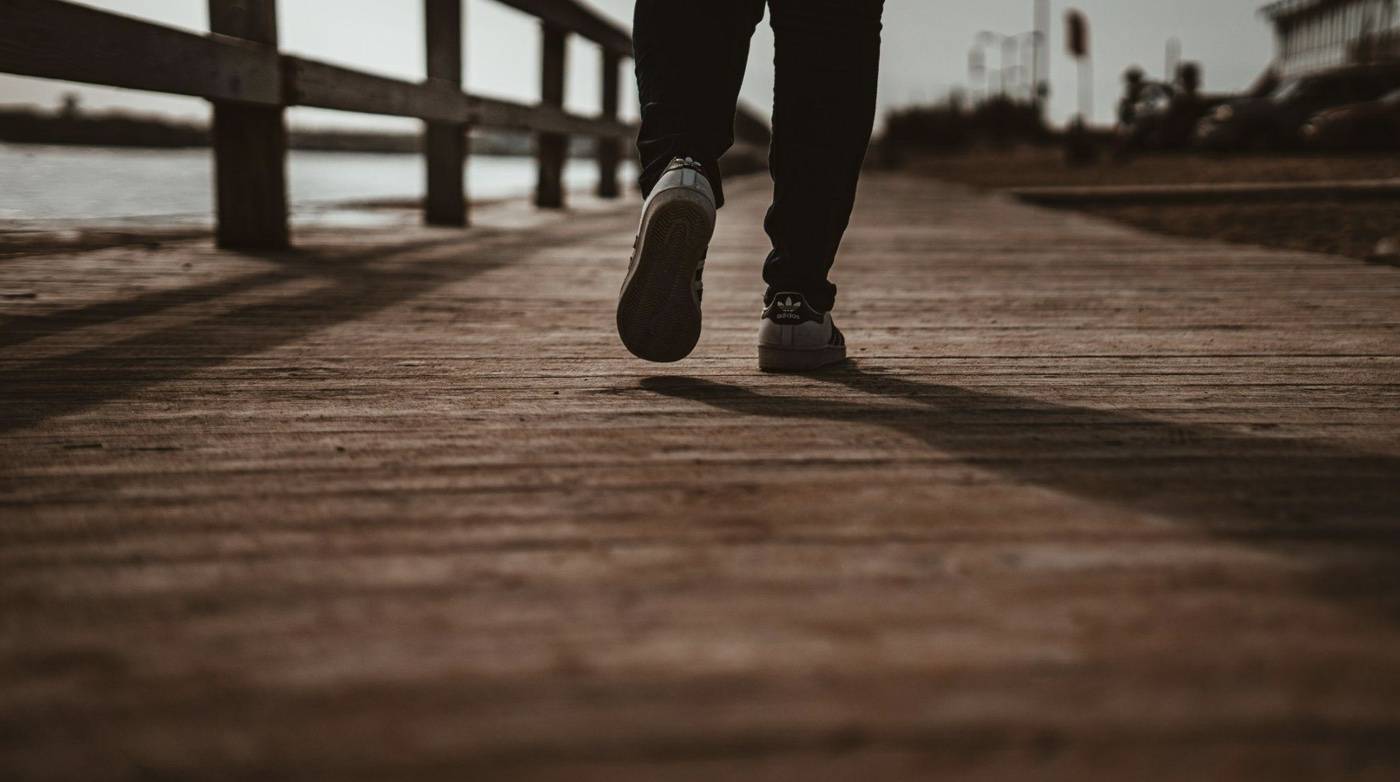Walk your way to a summer body with these walking tips and tricks. Learn the science behind the 10,000 steps rule, the best walking intensity, and more!

July 2022. This article is independently written by Shelby Golding. All opinions given are hers. Shelby has been certified as a personal trainer and nutritional specialist since 2007. In 2008, she found her passion for writing about these topics and hasn't looked back.

When fitness goals get set for a superficial reason - i.e., looking hot in your new bikini - they're less likely to succeed. Instead, most fitness experts recommend setting fitness goals that are specific, measurable, and attainable. Unfortunately, one study found that three out of four people who set fitness goals as their New Year's Resolution eventually give them up.
A summer body might seem like a specific fitness goal, but what are the components of your plan? Is the idea to exercise more? Eat better? Get defined abs?
Figuring out the details will help you stay on track and achieve the underlying desire behind the elusive summer body. One of the best exercise fitness goals is to start walking. Walking is an easy, low-impact form of exercise that most people can find a way to incorporate into their daily lives.
Keep reading to learn the health benefits of walking, the science behind the 10,000 steps rule, and more!
Health Benefits of Walking
Walking regularly has many benefits. When people start exercising for health, they often believe that high-intensity workouts are the most efficient ways to meet their goals. However, the simple act of walking every day can be equally as effective.
High-intensity workouts are not all they appear to be. HIIT (high-intensity interval training), running, and other intense workouts might eventually result in burnout, demotivation, or injury. The chances of burnout and injury increase if you suffer from chronic pain or illnesses.
Some of the benefits of walking include:
● Weight and fat loss
● Improved body composition
● Healthy metabolism
● Disease prevention and management
● Improved cardiovascular fitness
● Muscle strength
● Improved endurance
● Better mood
● Supports cognition and memory
● Better sleep and energy
● Healthy immune system
● Less tension and stress
The benefits of walking improve the longer you do it. So, if you start only walking for 20 minutes a day but then build up to 45 minutes to an hour of walking, the health benefits increase dramatically. You'll lose more weight, improve heart and muscle strength, and benefit from happier moods, better sleep, and fewer illnesses.
High-intensity workouts are not all they appear to be. HIIT (high-intensity interval training), running, and other intense workouts might eventually result in burnout, demotivation, or injury. The chances of burnout and injury increase if you suffer from chronic pain or illnesses.
Some of the benefits of walking include:
● Weight and fat loss
● Improved body composition
● Healthy metabolism
● Disease prevention and management
● Improved cardiovascular fitness
● Muscle strength
● Improved endurance
● Better mood
● Supports cognition and memory
● Better sleep and energy
● Healthy immune system
● Less tension and stress
The benefits of walking improve the longer you do it. So, if you start only walking for 20 minutes a day but then build up to 45 minutes to an hour of walking, the health benefits increase dramatically. You'll lose more weight, improve heart and muscle strength, and benefit from happier moods, better sleep, and fewer illnesses.
10,000 Steps A Day

You may have heard the rule popular on fitness tracking apps that you should be taking 10,000 steps a day. The CDC recommends 150 minutes of moderate exercise weekly. Walking 10,000 steps add up to about five miles a day, which more than satisfies your daily exercise needs.
If you're trying to lose weight, 10,000 steps burn anywhere from 2000 to 3500 calories a week. One pound of body fat is 3500 calories. So if you're eating well and consistent in your walking goals, you could lose a pound a week!
However, 10,000 steps a day is more of a suggestion than a rule: the more steps you take, the greater the benefits.
If you're just starting to walk for exercise, you should figure out your baseline - or the number of steps you take on average. Then start by adding 1,000 steps a day for a week to increase your baseline steadily.
If you're trying to lose weight, 10,000 steps burn anywhere from 2000 to 3500 calories a week. One pound of body fat is 3500 calories. So if you're eating well and consistent in your walking goals, you could lose a pound a week!
However, 10,000 steps a day is more of a suggestion than a rule: the more steps you take, the greater the benefits.
If you're just starting to walk for exercise, you should figure out your baseline - or the number of steps you take on average. Then start by adding 1,000 steps a day for a week to increase your baseline steadily.
The Best Walking Intensity
In terms of intensity, the only difference between walking and running a mile is that walking takes longer. The best intensity is one you can maintain for the duration of your walk. You do not have to be out of breath or sweating to get the health benefits.
Start by keeping your walking pace brisk, covering about a mile every 15 to 20 minutes. You can start with 10 minutes a day for the first couple of weeks, but then increase the time you walk until you can do 30 minutes a day. Ideally, you should walk every day.
As you begin to walk regularly, your endurance will increase so you can add distance and intensity to your walks.
One particularly effective training method for walking your way to a summer body is to incorporate interval training. For example, walking at a brisk pace for a minute, then switching to a slower pace for two minutes. Repeat this interval several times throughout your walk. Interval training helps burn calories, be more time-efficient, improve cardiovascular health and aerobic capacity, and keep your mind engaged.
Start by keeping your walking pace brisk, covering about a mile every 15 to 20 minutes. You can start with 10 minutes a day for the first couple of weeks, but then increase the time you walk until you can do 30 minutes a day. Ideally, you should walk every day.
As you begin to walk regularly, your endurance will increase so you can add distance and intensity to your walks.
One particularly effective training method for walking your way to a summer body is to incorporate interval training. For example, walking at a brisk pace for a minute, then switching to a slower pace for two minutes. Repeat this interval several times throughout your walk. Interval training helps burn calories, be more time-efficient, improve cardiovascular health and aerobic capacity, and keep your mind engaged.
How to Start Walking
You may think that you know how to walk without any guidance. But if you're trying to increase your routine's intensity, you should ensure you have the proper form.
Poor walking form can cause issues such as:
● Plantar fasciitis
● Shin splints
● Tendonitis
● Stress fractures
● Patellofemoral pain syndrome (runner’s knee)
● Iliotibial band syndrome
● Low back pain
● Achilles tendinopathy
To prevent walking-related injuries, begin by analyzing the way you walk. You should walk straight up and your eyes forward, with your shoulders back and down. Let your arms swing from the shoulders, not the elbows. Step lightly, rolling from the heel to the toe with each step, and keep a neutral pelvis. If you need help analyzing your walk, consult your primary care doctor or physical therapist.
The right gear will also support healthy form while walking. Your sneakers should be stable, flexible, and comfortable. Many professional shoe stores have processes to analyze your gait to help you choose the correct shoe based on the height of your arch, the width of your foot, and the needs of your activities.
Do not wear old shoes! Typically, walking shoes need to be replaced every 8 to 12 months. This is because shoes lose support and cushioning over time, leading to foot, knee, and leg pain.
Poor walking form can cause issues such as:
● Plantar fasciitis
● Shin splints
● Tendonitis
● Stress fractures
● Patellofemoral pain syndrome (runner’s knee)
● Iliotibial band syndrome
● Low back pain
● Achilles tendinopathy
To prevent walking-related injuries, begin by analyzing the way you walk. You should walk straight up and your eyes forward, with your shoulders back and down. Let your arms swing from the shoulders, not the elbows. Step lightly, rolling from the heel to the toe with each step, and keep a neutral pelvis. If you need help analyzing your walk, consult your primary care doctor or physical therapist.
The right gear will also support healthy form while walking. Your sneakers should be stable, flexible, and comfortable. Many professional shoe stores have processes to analyze your gait to help you choose the correct shoe based on the height of your arch, the width of your foot, and the needs of your activities.
Do not wear old shoes! Typically, walking shoes need to be replaced every 8 to 12 months. This is because shoes lose support and cushioning over time, leading to foot, knee, and leg pain.
Walk Your Way to Health
Walking is a simple way to create a healthy summer body. Its many benefits – from weight loss to heart health – make it easy to see why health enthusiasts have embraced the 10,000 steps rule. However, if you're planning to add walking to your health and wellness routine, practice good form and invest in the right equipment to prevent any walking-related injuries.
And if you’re dealing with old injuries, wear your Kailo Pain Patch when you head out on your walks! Kailo patches are designed to relieve pain in seconds, and they’re theorized to work by interfering with your body’s electrical system. A recent clinical study showed that 99% of patients felt pain relief with Kailo within 10 minutes of using a Kailo patch, and 100% of patients stop prescription medication after using Kailo for pain relief.
Disclaimer: Kailo should not be used if you have a pacemaker or if you are pregnant. Always consult your doctor or health care professional before using Kailo.
And if you’re dealing with old injuries, wear your Kailo Pain Patch when you head out on your walks! Kailo patches are designed to relieve pain in seconds, and they’re theorized to work by interfering with your body’s electrical system. A recent clinical study showed that 99% of patients felt pain relief with Kailo within 10 minutes of using a Kailo patch, and 100% of patients stop prescription medication after using Kailo for pain relief.
Disclaimer: Kailo should not be used if you have a pacemaker or if you are pregnant. Always consult your doctor or health care professional before using Kailo.






